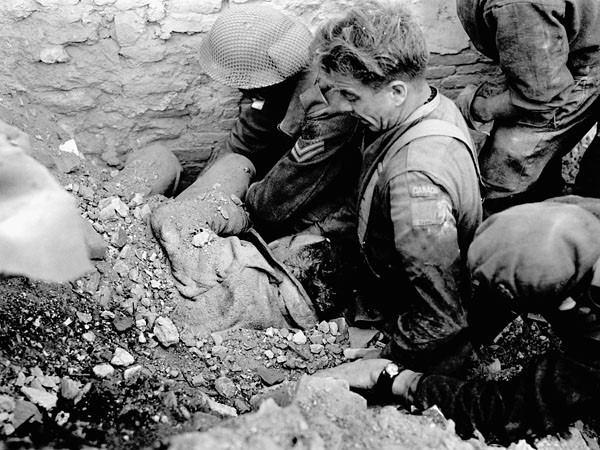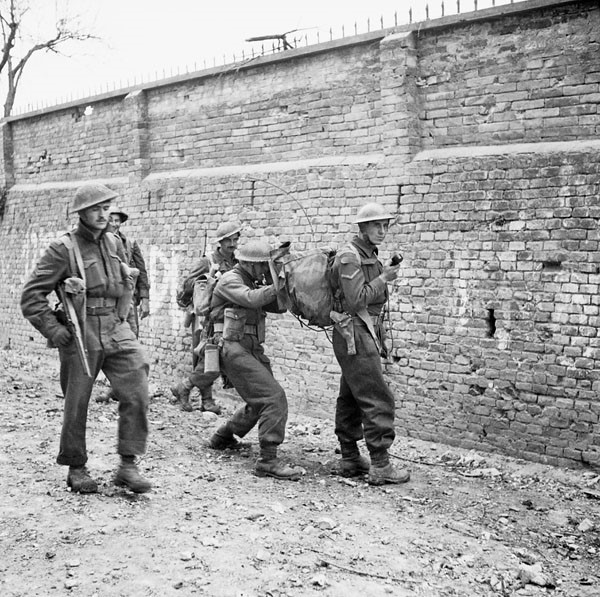Welcome to the December 2023 -January 2024 edition of The Despatch, the Military Communications and Electronics Museum Newsletter.
80 YEARS AGO! THE INVASION OF THE ITALIAN MAINLAND
In December 1943, Montgomery’s 8th Army (which included the Canadians) was tasked with breaking the far eastern section of the German Gustav Line. First up was the battle of Moro River and the Gully in early December. River crossings were always problematic for engineers and signals. There was an expectation that as soon as Artillery and Infantry commands halted, that a cable line would be run connecting them to Brigade headquarters. Maintaining that line in a combat situation was almost as difficult as laying the cable in the first place. Winter rains had turned the landscape into a quagmire. On 6 December, Canadians assaulted the Moro River defences in three places. The Hastings and Prince Edward Regiment was a diversion on the right flank, the Princess Patricia’s Canadian Light Infantry (P.P.C.L.I.) on the left and the Seaforth were to attack the main objective of San Leonardo. Only the P.P.C.L.I. made headway, capturing Villa Rogatti before being ordered to withdraw. Lineman crossed the Moro with the second company of The Hastings and Prince Edward Regiment and began laying line back to the RCRs who were following, under protective cover fire supplied by the Hastings and Prince Edward Regiment. Unfortunately, when the Regiment were successful in making their way across the river, radio failure meant they were unable to send a message of their success and call in much needed mortar fire to support their advance. ‘A’ and ‘C’ Company of the Seaforth were met with a hail of machine gun fire and communications with the Battalion Headquarters failed. The Hastings and Prince Edward Regiment were forced to retreat.
Artillery units struggled as well, with Artillery Signals under fire constantly from 88’s as they were the lynchpin for the control of all firing of the Divisional Artillery. Signals kept that line open through 5 days of shelling, so the Canadian Royal Artillery was always able to make fire corrections.
A firm bridgehead was finally established across the Moro on 9 December, but further advance was blocked by a deep, narrow pass nicknamed The Gully heavily defended by the Germans. The attacks began on the 10 December, 1943.
At 6:00 p.m. the three companies left San Leonardo for their start line, which was 500 yards north of the town. The attack failed completely. Little artillery support was possible, for fear of endangering the attackers, and what was given did not greatly disturb the enemy, well dug in below the near edge of the Gully. The confusion increased when the battalion lost its wireless sets and the artillery F.O.O. was killed. Early morning found the enemy-members of the 1st Battalion of the 200th Grenadier Regiment-still secure on their reverse slope. At eight o'clock Brigadier Gibson ordered the West Novas to renew the attack towards Berardi, and the fight continued in driving rain. Again wireless communication was destroyed as rapidly as it could be repaired or replaced. Four times the Grenadiers launched counter-attacks, but the Canadian battalion held its ground. In repulsing one of these thrusts forward elements of the West Novas, eager to close with the enemy, left their slit-trenches and were drawn forward to the crest, where intense machine-gun fire from across the Gully added to an already long casualty list. During the morning the C.O., Lt.-Col. M.P. Bogert, was wounded, but he continued to direct the fight until relieved in the afternoon. The deadlock could not be broken. The West Novas, having lost more than 60 killed and wounded, dug in and awaited another plan. Nicholson, Gerald. Official History of the Canadian Army in the Second World War. Volume II: The Canadians in Italy, 1943-1945 (Queen's Printer, Ottawa, ON, 1957)
The Gully Crossing resulted in the award of the Victoria Cross to Captain Paul Triquet of the Royal 22e Régiment, for “his courageous and determined leadership resulting in the capture and retention of Casa Berardi.” It took until the 19th of December, 1943 to firmly secure the Gully so the Canadians could move to the town of Ortona. The fight to take a 2500 yard stretch from San Leonardo to the Ortona road had involved each brigade of the 1st Canadian Division, as well as the 1st Canadian Armoured Brigade.
On December 20, 1943 the Canadians began their advance to Ortona. The battle for Ortona has been compared to a “Little Stalingrad” and is still used as an example of how to conduct urban warfare by military trainers and academics. The Allies expected Ortona to be taken peacefully, and as they wished to turn it into an administrative centre, complete with port facilities, the city proper was spared any serious ai or land bombardment. The Germans plans hinged on holding Ortona. They demolished the city, making sure that tanks could not be easily deployed and mined, and booby trapped the whole city. Kill zones were created and side streets were blocked off, channelling would-be attackers up the main streets.

Caption: Infantrymen of The Loyal Edmonton Regiment rescuing Lance-Corporal Roy Boyd, who was trapped under rubble for 3 1/2 days, Ortona, Italy, 30 December 1943. Credit LAC. On December 26, 1943 the savagery of the battle was illustrated by the demolition of a house containing a Canadian platoon; 23 men were killed and 1 man buried alive for three days. German pioneers had booby trapped the house with a sizeable explosive charge.
Ortona became a battle of small groups of men clearing houses and even rooms one at a time, using grenades and a tactic called “mouseholing. This was the use of demolitions to move from one building to another, by blowing holes in rooftops or walls that the Canadians used to clear the building of Germans. Casualties were high for both German paratroopers and the Canadians. Booby trapped and mined houses killed whole groups of men, up to 50 at a time. Line was carried by hand and repaired under dangerous conditions as going into the streets of Ortona was a death sentence. German snipers made sure to concentrate on killing officers, NCOs, and signallers.

Private W.L. Waske operates the radio, which is carried by Lance-Corporal W.D. Smith. Credit LAC.
Ortona fell to the Canadians on December 28th when the German paratroopers left the town in the middle of the night. Casualties for the Canadians were high with over 500 dead and 1500+ wounded or captured. By January 4th, Canadian troops had fought their way north of Ortona and seized the Torre Mucchia headland, also known, to the Germans as well as the Canadians, as Point 59. Here the Canadian troops would overwinter and consolidate their hold on the area and rest and recover.
Karen Young
Museum Manager
Mid Winter Blues
January is often a difficult month for many of us. It's cold, it's dark, the holidays are over, and we often take the time at the beginning of a new year to reflect on the past and on our future. Mentally and emotionally a lot of us are vulnerable at this time of year. So how can you help your mental health throughout the year?
Often, the secret to feeling better about yourself and your situation is to invest some time and energy into what makes you feel better. Did you know that visiting a cultural attraction of your choice can boost your happiness?
Well, it can!
1) Visiting a museum or Art Gallery is a positive experience and stimulates positive emotions.
2) It reduces cortisol levels. Being in a museum or Art Gallery actually reduces your stress level which has a positive impact on your overall health.
3) It helps reduce isolation. Museums and art galleries are filled with like-minded people all trying to enjoy an experience together.
So invest some time in your mental health and get out and about!
Check out the KAM website for art galleries, museums and attractions open in January to help with those midwinter blues. https://www.kingstonmuseums.ca/
Karen Young
Museum Manager
Museum Happenings
Welcome to 2024!
As you read this, I am officially retired from the Military Communications and Electronics Museum. The acting manager, Annette Gillis, is now responsible for the museum. Annette has been acting manager of the Museum in the past, so you are in good hands. In the spring, you will have a brand-new Museum Manager and there will be lots of new and exciting times ahead for the Military Communication and Electronics Museum. Bio and photo of the new manager will be in the February edition of the Garrison Newsletter. Please give them a warm welcome!
I would be remiss if I did not do a shout out to the many volunteers who have supported the writing of the Despatch; Captain Sean Maas Stevens and Bill Cowperthwaite for their articles and Cpl Tetiana Winchester for translation when she was available. Thank you for supporting the Military Communication and Electronics Museum for all these years!
The Museum has been a recipient of two City of Kingston Heritage Fund grants for 2024 to create a Kingston-wide Veterans' Events for Veterans week 2024. We will be reaching out to organizations interested in participating in the development and delivery of these events in early 2024.
The museum galleries remain closed until February 12, 2024 for exhibit cleaning, conservation and installation. The Mercury Shop and the conference rooms will be open as of January 8, 2024.
Family Day and March of the Museums is right around the corner. Check us out on Facebook, Instagram, X or our website for future posts about our events.
I'd like to thank CFSCE, PSP, KMFRC and the local community for being such a steadfast supporter of the Military Communication and Electronics Museum. It has been an honour to be your Museum Manager.
Karen Young
Museum Manager
Coffee with Veterans
This month our Coffee with Veterans is being held on Tuesday, January 16, 2024 at 1000. All Welcome! Proudly sponsored by ADGA Group. https://www.adga.ca/

Mercury Shop
The Mercury Shop will reopen on January 8, 2024.
New Year, new products! The Mercury Shop is bringing in new tumblers, keychains, corporate name tags and shirts. We will also be introducing some new toys and games into the shop before March of the Museums.
If you need something custom-made the Mercury Shop can do laser engraving and sublimation of your own design into various products.
The Mercury Shop has a wide range of military accoutrements available as well as our medal mounting service all year round. Our hours are 1000 to 1530 Monday to Friday.
For more information about any of our other services, please reach out to the Mercury Shop by phone 613-541-5395 or email mercuryshop@candemuseum.org
Leala Hampel, Mercury Shop Supervisor
Not Forgotten – John Stiby Groves – 107252
References:
A. https://central.bac-lac.gc.ca/.item/?op=pdf&app=CEF&id=B3863-S021
B. https://www.cwgc.org/find-records/find-war-dead/casualty-details/44486/john-stiby-groves/
C. http://www.rcsigs.ca/index.php/File:Groves,_John_Stiby_grave_marker.jpg
John Stiby Groves was born in Bingham, England on 18 July 1892 to Ernest and Frances M. Groves. Leaving his livelihood as a farmer in 1914, John enlisted with the Canadian Expeditionary Force on 8 December, in Victoria, British Columbia. He was assigned to the 2nd Canadian Mounted Rifles, and joined at the rank of Private (or Trooper depending on the document).
Likely while on training in BC, Pte Groves fell ill and spent 6 days in the camp hospital starting on 27 Feb 1915. Following his recovery, he boarded a ship in June, and though his time in England is unaccounted for, he arrived in France on 22 September 1915. While in the field in November of 1915, Pte Groves was authorized for posting to the Signal Corps, and subsequently promoted to Corporal. On 8 January 1916, he was officially taken on strength with the 3rd Divisional Canadian Signal Company.
Tragically, Cpl Groves was in a Motorcycle accident only a week after his assignment to the Signal Company, and was admitted to the hospital with a fracture at the base of his skull. He succumbed to his injury on 17 January 1916. He was 22 years old.
Corporal John Stiby Groves is buried in the Hazebrouck Communal Cemetery. His headstone was commissioned by his father, Ernest, and reads:
107252 CORPORAL
J.S. GROVES
3RD CAN DIV. SIGNAL COY.
17TH JANUARY 1916 AGE 22

